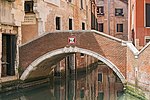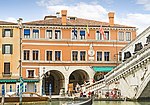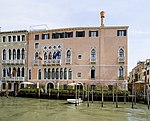San Giovanni Elemosinario

San Giovanni Elemosinario is a church of Venice, northern Italy, dedicated to Saint John the Almsgiver. This church was founded in 1071, and was completely destroyed by the disastrous Rialto fire in 1514. The church was rebuilt by Antonio Abbondi called Scarpagnino. The painter Antonio Vassilacchi worked here in the 16th century. Nestled into the dense area near the Rialto Market (with your back to the Bridge on the San Polo side, turn left just past the flea market booths; the entrance will be through the frescoed arch behind iron gates on your left). The altarpiece on the high altar depicts St. John the Almsgiver (1545-1550) by Titian; the right apse chapel houses Saints Catherine, Sebastian and Roch (c. 1533) by il Pordenone.
Excerpt from the Wikipedia article San Giovanni Elemosinario (License: CC BY-SA 3.0, Authors, Images).San Giovanni Elemosinario
Calle del Pozzetto, Mestre Venezia-Murano-Burano
Geographical coordinates (GPS) Address Nearby Places Show on map
Geographical coordinates (GPS)
| Latitude | Longitude |
|---|---|
| N 45.438769444444 ° | E 12.333913888889 ° |
Address
Calle del Pozzetto
Calle del Pozzetto
30170 Mestre, Venezia-Murano-Burano
Veneto, Italy
Open on Google Maps











